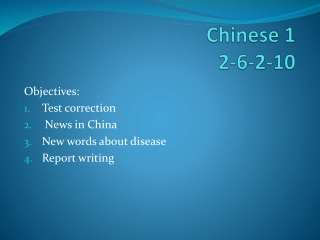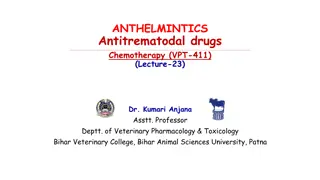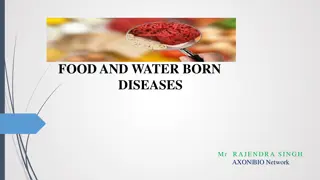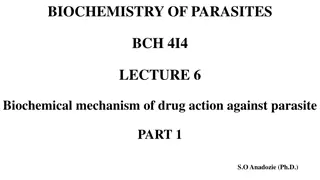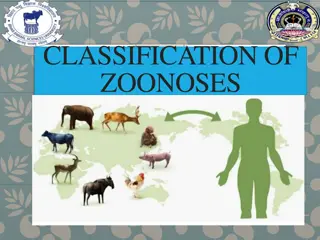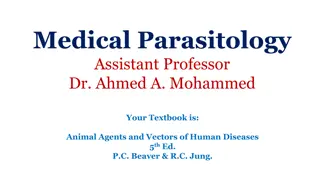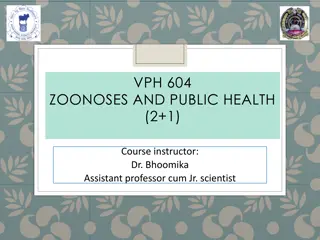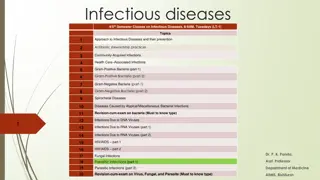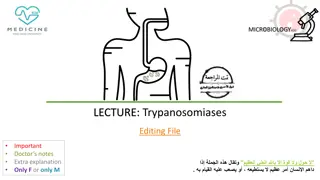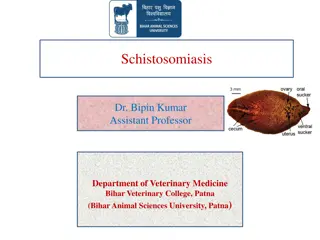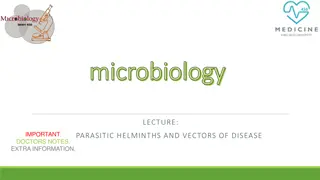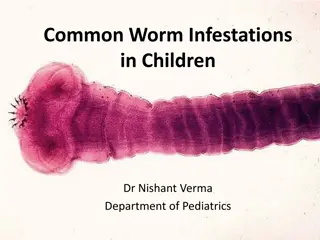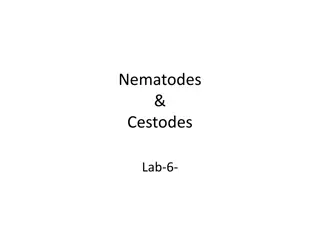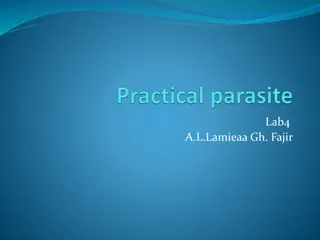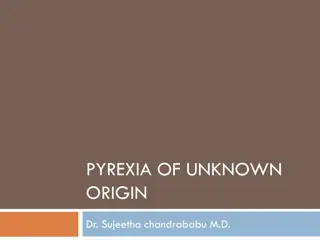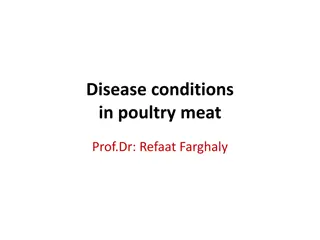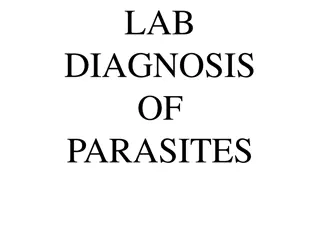Study Materials for Learning about Diseases and Telling Time
Dive into a collection of study resources covering test corrections, news updates from China, new vocabulary related to diseases, and report writing tasks. Explore new words, grammar rules for telling time, and objectives for each day of the week. Get insights on recent developments in China, includ
0 views • 13 slides
Overview of Poultry Diseases and their Causes
Poultry diseases caused by viruses and bacteria are a significant concern for poultry farmers. Viral diseases like Ranikhet Disease, Fowl Pox, and Avian Leucosis can have high mortality rates and severe symptoms. Bacterial diseases such as Tick Fever, Tuberculosis, Fowl Cholera, and Infectious Coryz
2 views • 12 slides
Periodontal Treatment Considerations for Medically Compromised Patients
Patients with significant medical conditions may require special considerations for periodontal treatment. Medical issues such as hemorrhagic disorders, renal diseases, liver diseases, pulmonary diseases, infectious diseases, pregnancy, medications, and cancer therapies can impact oral health and tr
1 views • 87 slides
Best Neurosurgery Hospitals in India
Neuro diseases are very bad diseases. Many people are caught by Neuro diseases nowadays. It is related to brain diseases. Many people in India are caught by Neuro Diseases. It happens in Adults as well as children.\nA person of any age can be affected by this. Before this time very bad disease Named
1 views • 2 slides
Overview of Nutritional Diseases and Disorders
Nutritional diseases arise from imbalances between the body's nutrient and energy requirements and their supply. Nutritional deficiencies can lead to clinical diseases, while excessive intake can result in diseases of affluence. Common nutritional disorders include low birth weight, PEM, obesity, go
4 views • 6 slides
Neonatal Diseases
Neonatal and postnatal diseases in livestock, with a focus on perinatal, neonatal, and postnatal stages. It covers common classifications, causes, and risk factors associated with these diseases, particularly focusing on neonatal diarrhea (Calf Scour). The content delves into noninfectious and infec
0 views • 33 slides
Understanding Fungal and Protist Diseases: Impacts and Prevention
Fungi and protists play significant roles as pathogens, causing diseases in both humans and plants. Fungal diseases like athletes foot and protist diseases like malaria can have serious impacts on health. Control measures such as understanding symptoms, spread mechanisms, and prevention strategies a
0 views • 10 slides
Understanding Antitrematodal Drugs and Their Applications in Veterinary Medicine
Fascioliosis caused by F. hepatica is a common concern globally, impacting livestock health and economy. Antitrematodal drugs play a crucial role in combating parasitic infections like fascioliosis. One such drug, Carbon tetrachloride (CCl4), has been effective in treating F. hepatica due to its act
0 views • 33 slides
Overview of Clostridial Diseases Caused by Clostridium Bacteria
Clostridial diseases are caused by bacteria of the genus Clostridium, which are anaerobes commonly found in soil, feces, and healthy animal tissues. These bacteria can lead to various diseases in animals such as black quarter, gas gangrene, necrotic dermatitis, and more. Understanding the different
0 views • 55 slides
Understanding Food and Water-Borne Diseases: Causes and Classification
Food and water-borne diseases, caused by contaminated food or water, lead to acute illnesses. These diseases are classified into food-borne infections and food-borne intoxications. Food-borne infections, triggered by pathogenic microorganisms, can be fungal, bacterial, viral, or parasitic, with long
3 views • 57 slides
Managing Nutritional and Metabolic Diseases in Zoo and Wild Animals
The prevention, control, and treatment of nutritional and metabolic diseases in zoo and wild animals are essential for maintaining their health. These diseases, such as rickets, osteoporosis, osteomalacia, and fibrous osteodystrophy, can result from imbalances in dietary nutrients and metabolic dera
0 views • 10 slides
Understanding Biochemical Mechanisms of Drug Action Against Parasites
Parasitic protozoa cause devastating diseases in humans and animals, and chemotherapy is the primary defense. Drug resistance is a challenge, and prevention is crucial. Modern tools aid in studying genetic and biochemical aspects, targeting the parasite selectively. Drugs act by interfering with spe
1 views • 15 slides
Understanding the Classification of Zoonoses
Zoonoses, diseases that can be transmitted from animals to humans, are classified based on etiological agents, transmission cycle, and reservoir hosts. Etiological agents include bacteria, viruses, rickettsial, chlamydial, mycotic, and parasitic organisms. The transmission cycle categorizes zoonoses
2 views • 18 slides
Understanding Parasitic Relationships in Medical Parasitology
Medical Parasitology delves into the intricate relationships between parasites and their hosts, encompassing symbiosis, mutualism, commensalism, and parasitism. The success of a parasite hinges on achieving a delicate balance with its host, avoiding expulsion or harm. Various types of parasites are
0 views • 12 slides
Understanding Anthelmintics: Drug Therapy for Parasitic Worm Infections in Veterinary Medicine
Anthelmintics are essential drugs to combat parasitic worm infections in animals. They work either by killing (vermicide) or expelling (vermifuge) the worms, reducing worm burdens and controlling infections. This comprehensive overview covers different aspects of anthelmintics, including their prope
2 views • 34 slides
Infectious Diseases 4/5th Semester Classes: Approach & Prevention
Infectious Diseases class focuses on various topics including Antibiotic Stewardship Practices, Community-Acquired Infections, Gram-Positive and Gram-Negative Bacteria, Spirochetal Diseases, Diseases Caused by Bacterial and Viral Infections, HIV/AIDS, Fungal and Parasitic Infections. The class also
3 views • 30 slides
Comprehensive Overview of Gastrointestinal Tract Diseases
This detailed guide covers various gastrointestinal tract diseases caused by protozoa and helminths, including amebiasis, giardiasis, pinworm infestation, and trichinosis. It discusses their causes, symptoms, transmission, treatment, and prevention methods. The content provides insights into the lif
0 views • 9 slides
Overview of Giardia lamblia Parasite and Giardiasis Disease
Giardia lamblia, also known as Giardia intestinalis, is a flagellated parasitic microorganism that causes giardiasis by colonizing the small intestine. It infects humans, cats, dogs, and birds, and is a common parasitic human disease globally. Giardiasis, popularly known as beaver fever, can lead to
0 views • 12 slides
Zoonotic Diseases in Mongolia: A One Health Perspective
High risk of zoonosis in Mongolia is evident due to various factors such as livestock practices, wildlife diseases, and environmental changes. The National Center for Zoonotic Diseases in Mongolia plays a crucial role in studying, preventing, and raising awareness about over 160 zoonotic infectious
0 views • 13 slides
Immune Responses to Parasitic Infections and Evasive Strategies by Protozoan and Helminth Parasites
Parasitic infections pose complex challenges to the immune system due to the diverse nature of parasites, including protozoans and helminths. Protozoan parasites move between arthropod vectors and mammalian hosts, requiring both humoral and cell-mediated immune responses. Meanwhile, helminths, as mu
0 views • 15 slides
Understanding Zoonoses in Public Health: Classification and Transmission Cycles
Zoonoses, diseases transmitted from animals to humans, are classified based on etiological agents, transmission cycles, and reservoir hosts. The classification includes bacterial, viral, rickettsial, chlamydial, mycotic, and parasitic zoonoses. Transmission cycles are categorized as direct, cyclozoo
0 views • 19 slides
Comprehensive Overview of Infectious Diseases and Symbiosis in Academic Setting
This academic course covers a wide array of topics related to infectious diseases, including antibiotic stewardship, bacterial infections, viral diseases like HIV/AIDS, fungal and parasitic infections, and parasite life cycles. Additionally, it delves into the intricacies of symbiosis, exploring com
0 views • 24 slides
Understanding Trypanosomiases: African Sleeping Sickness and Chagas Disease
Trypanosomiases are parasitic diseases caused by Trypanosoma parasites, with African sleeping sickness and Chagas disease being the two main types affecting humans. African sleeping sickness, transmitted by the tsetse fly, can lead to chronic or acute illness and is primarily found in Africa. The di
0 views • 13 slides
Understanding Human Parasites: Laboratory Testing, Neglected Tropical Diseases, and More
Explore the world of human parasites through laboratory testing for intestinal, blood, and tissue parasites. Learn about neglected tropical diseases, common parasitic disease exposures, Texas notifiable conditions, and additional parasites to be aware of. Traditional parasitology techniques involvin
0 views • 19 slides
Overview of Amoebae: Parasitic and Free-Living Varieties
Various types of amoebae, including parasitic Entamoeba histolytica and harmless commensal amoebae, are discussed in terms of their morphology, epidemiology, pathogenesis, clinical presentation, diagnosis, treatment, and habitats, such as the large intestine and water sources. Pathogenic free-living
0 views • 9 slides
Trends in Parasitic Copepod Infection Among Juvenile Salmonids in WVP Reservoirs Study
Study conducted by the Oregon Department of Fish and Wildlife researchers to investigate trends in parasitic copepod infection among juvenile salmonids in WVP reservoirs. The study focuses on the prevalence and intensity of infection on the gills, comparing infection levels between stream-rearing an
0 views • 12 slides
Overview of Schistosomiasis and Fascioliasis in Veterinary Medicine
Schistosomiasis and Fascioliasis are important parasitic diseases affecting animals, particularly ruminants and horses. Schistosomiasis, caused by Schistosoma species, can lead to severe symptoms such as diarrhea, weight loss, anemia, and eosinophilia. On the other hand, Fascioliasis, caused by Fasc
0 views • 10 slides
Common Regulated Diseases in Imported Fruit and Vegetables
Imported fruit and vegetables can carry regulated diseases such as Citrus Black Spot, Citrus Scab, and Citrus Canker. These diseases affect citrus fruits and peppers, causing scabs, spots, and cankers, making the produce unmarketable. The pathogens causing these diseases have been intercepted in imp
0 views • 12 slides
Understanding Prion Diseases: A Comprehensive Overview
Prion diseases, such as Transmissible Spongiform Encephalopathies (TSEs), are rare and fatal neurological disorders affecting both humans and animals. These diseases are characterized by long incubation periods, neuronal loss, and the absence of an inflammatory response. Caused by abnormal folding o
0 views • 12 slides
Understanding Infectious Diseases: Approach, Prevention, and Viral Agents
Infectious diseases play a significant role in public health, with a focus on antibiotic stewardship, community-acquired and healthcare-associated infections, as well as various bacterial, viral, fungal, and parasitic agents. Specific topics include the prevention of infectious diseases, with a deta
0 views • 18 slides
Understanding Parasitic Helminths and Disease Vectors in Microbiology
Explore the world of parasitic helminths and disease vectors in microbiology. Learn about the classification of parasites, the life cycle of Ascaris lumbricoides, and the role of arthropods as agents and vectors of diseases in humans. Discover the characteristics of the three main groups of parasiti
0 views • 18 slides
Understanding Parasitic Helminths and Arthropod Vectors of Diseases by Dr. Mona Badr
This educational material delves into the classification, morphology, and life cycles of parasitic helminths, focusing on the roundworm Ascaris lumbricoides. It also explores the role of arthropods as agents and vectors of diseases in humans, providing insights into the location of helminthes in the
0 views • 28 slides
Understanding Apicomplexa: The Intriguing World of Parasitic Protozoa
Apicomplexa, a group of unicellular, spore-forming parasites, exhibit a complex life cycle involving sexual and asexual stages. Coccidia, a type of Apicomplexan parasite, cause diseases like coccidiosis in humans and animals. The disease spreads through contact with infected feces or tissue, leading
0 views • 36 slides
Overview of Common Worm Infestations in Children and Neglected Tropical Diseases (NTDs)
Common worm infestations in children, such as Ascaris lumbricoides and Enterobius vermicularis, are a significant health concern globally. Neglected Tropical Diseases (NTDs) like ascariasis, hookworm, and lymphatic filariasis affect millions of people, particularly those in poverty. For just 50 cent
0 views • 25 slides
Parasitic Worms: Nematodes and Cestodes Overview
Explore the world of parasitic worms with a focus on Nematodes and Cestodes. Learn about Wuchereria bancrofti causing lymphatic filariasis and Echinococcus species leading to hydatid disease. Discover the transmission, laboratory diagnosis, treatment, and clinical aspects associated with these patho
0 views • 12 slides
Understanding Parasitic and Non-Parasitic Materials in Feces Examination
When examining feces for parasites, it's crucial to differentiate between parasitic material, non-parasitic material, and pseudoparasites. Recognizing parasite eggs and cysts based on their shape and size is essential for accurate identification. Additionally, being aware of non-parasitic materials
0 views • 7 slides
Understanding Pyrexia of Unknown Origin: Causes and Classification
Pyrexia of unknown origin (PUO) is a challenging diagnostic scenario characterized by persistent fever without an identified cause. Dr. Sujeetha Chandrababu M.D. defined PUO as temperatures exceeding 38.3°C for several weeks with no definitive diagnosis. Classification of PUO includes various categ
0 views • 43 slides
Understanding Rickettsial Diseases: Epidemiology, Pathogenesis, and Clinical Features
Rickettsiae are pleomorphic intracellular coccobacilli with unique parasitic behavior, leading to vascular lesions and systemic manifestations in humans. The infections are spread by insect vectors and are characterized by fever, headache, malaise, skin rash, and organ enlargement. Different types o
0 views • 21 slides
Disease Conditions in Poultry Meat: Causes, Symptoms, and Lesions
This detailed information by Prof. Dr. Refaat Farghaly discusses various disease conditions in poultry meat, including bacterial, viral, parasitic, and protozoal diseases. It covers diseases such as tuberculosis, fowl cholera, marek's disease, salmonellosis, and coccidiosis, providing insights into
0 views • 28 slides
Laboratory Diagnosis of Parasites: Methods and Clinical Specimens
Laboratory diagnosis of parasitic infections involves techniques such as demonstration of parasites, immunodiagnosis, and molecular biological methods. Clinical specimens for diagnosis include blood, urine, genital specimens, sputum, and tissue biopsy/aspiration. Chyluria, a condition with milky whi
0 views • 24 slides
